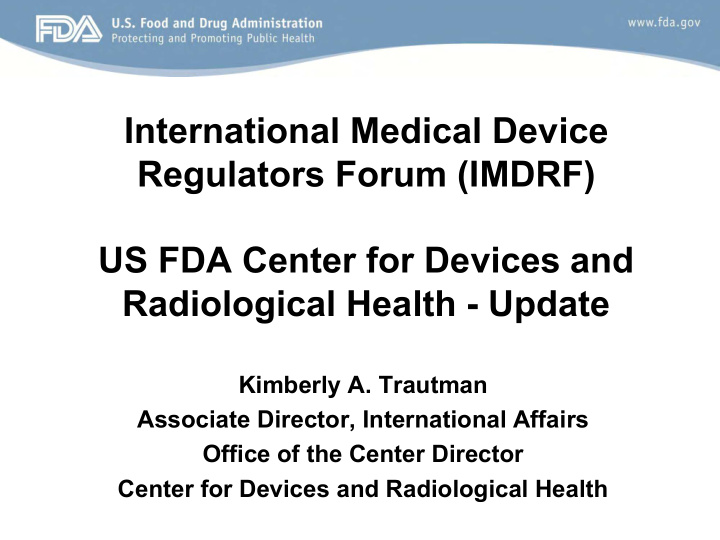



International Medical Device Regulators Forum (IMDRF) US FDA Center for Devices and Radiological Health - Update Kimberly A. Trautman Associate Director, International Affairs Office of the Center Director Center for Devices and Radiological Health
UDI Final Rule Published • September 20, 2013 – The UDI system consists of two core items. The first is a unique number assigned by the device manufacturer to the version or model of a device, called a unique device identifier. This identifier will also include production- specific information such as the product’s lot or batch number, expiration date, and manufacturing date when that information appears on the label. 2
UDI Final Rule Published • September 20, 2013 – The second component is a publicly searchable database administered by the FDA, called the Global Unique Device Identification Database (GUDID) that will serve as a reference catalogue for every device with an identifier. No identifying patient information will be stored in this device information center. 3
UDI Final Rule Published In general, high-risk medical devices (Class III) will be required to carry unique device identifiers on their label and packaging within one year and this number and corresponding device information must be submitted to the new database. Manufacturers will have three years to act for most Class II (moderate risk) devices. Manufacturers of Class I devices not exempt from UDI requirements will have five years to act. 4
Mobile Medical Applications Final Guidance • September 23, 2013 The agency intends to exercise enforcement discretion (meaning it will not enforce requirements under the Federal Drug & Cosmetic Act) for the majority of mobile apps as they pose minimal risk to consumers. The FDA intends to focus its regulatory oversight on a subset of mobile medical apps that present a greater risk to patients if they do not work as intended. 5
Mobile Medical Applications Final Guidance The FDA is focusing its oversight on mobile medical apps that: • are intended to be used as an accessory to a regulated medical device – for example, an application that allows a health care professional to make a specific diagnosis by viewing a medical image from a picture archiving and communication system (PACS) on a smartphone or a mobile tablet; or 6
Mobile Medical Applications Final Guidance • transform a mobile platform into a regulated medical device – for example, an application that turns a smartphone into an electrocardiography (ECG) machine to detect abnormal heart rhythms or determine if a patient is experiencing a heart attack. 7
Mobile Medical Applications Final Guidance Mobile medical apps that undergo FDA review will be assessed using the same regulatory standards and risk-based approach that the agency applies to other medical devices. 8
Additional Draft Guidance Document “Content of Premarket Submissions for Management of Cybersecurity in Medical Devices - Draft Guidance for Industry and Food and Drug Administration Staff” This guidance has been developed by the FDA to assist industry by identifying issues related to cybersecurity that manufacturers should consider in preparing premarket submissions for medical devices. 9
Cybersecurity Draft Guidance The need for effective cybersecurity to assure medical device functionality has become more important with the increasing use of wireless, Internet- and network-connected devices, and the frequent electronic exchange of medical device- related health information. 10
Recent FDA Guidance Document • Thursday, November 7, 2013 “ Design Considerations for Pivotal Clinical Investigations for Medical Devices; Guidance for Industry, Clinical Investigators, Institutional Review Boards and Food and Drug Administration Staff ” 11
Design Considerations for Pivotal Clinical Investigations Guidance to those involved in designing clinical studies that support premarket submissions for medical devices and FDA staff who review those submissions. Although the Agency has articulated policies related to design of studies intended to support specific device types, and a general policy of tailoring the evidentiary burden to the regulatory requirement, the Agency has not attempted to describe the different clinical study designs that may be appropriate to support a device premarket submission, or to define how a sponsor should decide which pivotal clinical study design should be used to support a submission for a particular device. 12 The guidance document describes different study design principles relevant to the development of medical device clinical studies that can be used to fulfill premarket clinical data requirements. The guidance is not intended to provide a comprehensive tutorial on the best clinical and statistical practices for investigational medical device studies.
Design Considerations for Pivotal Clinical Investigations The guidance document describes different study design principles relevant to the development of medical device clinical studies that can be used to fulfill premarket clinical data requirements. The guidance is not intended to provide a comprehensive tutorial on the best clinical and statistical practices for investigational medical device studies. 13
Recommend
More recommend